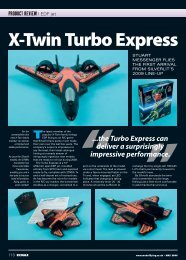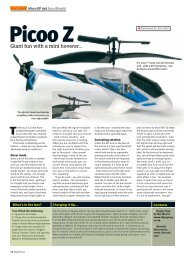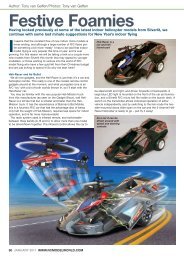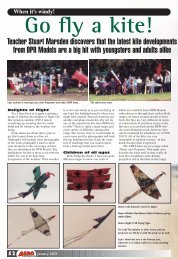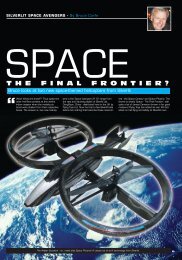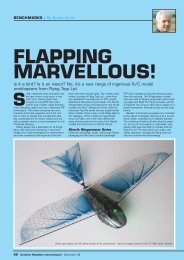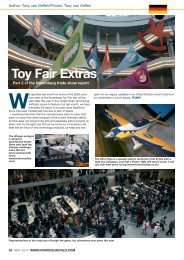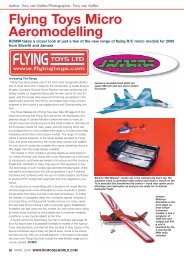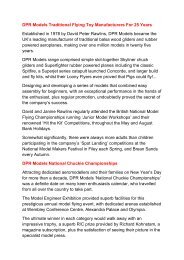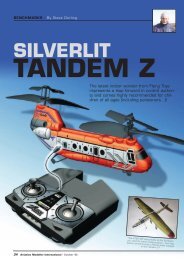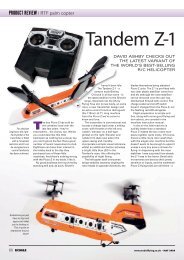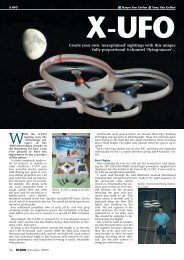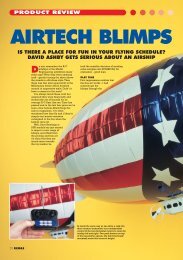John Stennard's colum for the indoor flyer - Flying Toys Ltd
John Stennard's colum for the indoor flyer - Flying Toys Ltd
John Stennard's colum for the indoor flyer - Flying Toys Ltd
Create successful ePaper yourself
Turn your PDF publications into a flip-book with our unique Google optimized e-Paper software.
In place on my FlightLine Chirp<br />
<strong>the</strong> DTRx35 functions perfectly<br />
Watts Under The Roof<br />
Watts Under The Roof<br />
<strong>John</strong> Stennard’s <strong>colum</strong> <strong>for</strong> <strong>the</strong> <strong>indoor</strong> <strong>flyer</strong><br />
At <strong>the</strong> time of writing a very<br />
dismal spell of wea<strong>the</strong>r has<br />
put paid to most outdoor<br />
flying and made <strong>indoor</strong> flying<br />
even more attractive. We are<br />
definitely going to consider how our club can<br />
arrange ‘emergency’ <strong>indoor</strong> flying sessions if<br />
<strong>the</strong> wea<strong>the</strong>r continues to be an issue. These<br />
days it’s easy to contact club members by<br />
email and if <strong>the</strong> wea<strong>the</strong>r <strong>for</strong>ecast is dire, or<br />
we have had weeks of un-flyable conditions,<br />
it should be possible to arrange some <strong>indoor</strong><br />
sessions. With <strong>indoor</strong> in mind I’m looking<br />
in detail at some new and interesting items<br />
that have just arrived, <strong>the</strong> DelTang range of<br />
DSM2 compatible receivers and <strong>the</strong> Silverlit<br />
Spy Cam camera equipped helicopter.<br />
Smaller and Smaller!<br />
The name DelTang might not be<br />
immediately recognised but I’m sure <strong>the</strong><br />
name of David Theunissen will be. David is<br />
a very active and innovative electric model<br />
aircraft builder and I have seen some of<br />
his impressive models in action. DelTang<br />
is <strong>the</strong> name of David’s new micro receiver<br />
venture and I’ll let David comment on <strong>the</strong><br />
origins of his exciting new lightweight DSM2<br />
compatible receivers. David says...<br />
‘I am branding <strong>the</strong>m ‘DT’ receivers. David<br />
Theunissen = DT = Delta Tango = DelTang,<br />
this is <strong>the</strong> full evolution of <strong>the</strong> names. The<br />
receivers just started out as cool stuff I<br />
made <strong>for</strong> myself and friends but o<strong>the</strong>r<br />
modellers now want <strong>the</strong>m. The designs and<br />
software are all mine and have evolved over<br />
about 30 different versions I have built and<br />
evaluated. The Rx 31-43 are targeted at<br />
models where adding any <strong>for</strong>m of case or<br />
even heat-shrink would be an unnecessary<br />
weight. However, <strong>the</strong>y can still be used in<br />
larger models and should have good range.<br />
This family has <strong>the</strong> auto-binding feature,<br />
as <strong>the</strong>y are mostly too small <strong>for</strong> bind plugs.<br />
Rxs 22/71/72 are a more robust range.<br />
They are still light <strong>for</strong> <strong>the</strong>ir features but <strong>the</strong>ir<br />
PCB’s are thicker and <strong>the</strong>y have heat-shrink<br />
covering.<br />
They have software that focuses on<br />
reducing latency. Rx 22 has been my main<br />
outdoor sport Rx <strong>for</strong> a couple of years and<br />
Rx 33-36 should be as good. All receivers<br />
have 7-channel data available on one pin,<br />
which Spektrum Rx’s don’t provide. Quite a<br />
few people are using <strong>the</strong>m in quad copters.<br />
Rx 31 is great <strong>for</strong> palm-sized versions.’<br />
The specifications and in<strong>for</strong>mation about<br />
each receiver run to several pages and<br />
can be viewed and downloaded from<br />
<strong>the</strong> Internet. The whole range of David’s<br />
products can be seen on his Fly Electric!<br />
website (see Contacts), which also includes<br />
o<strong>the</strong>r items. Just <strong>the</strong> receivers can be<br />
viewed on <strong>the</strong> DelTang website (see<br />
Contacts) or on <strong>the</strong> Micron Radio Control<br />
website (see Contacts). David sells his<br />
receivers direct or <strong>the</strong>y can be purchased<br />
from Andy at Micron Radio Control.<br />
I’m always interested in any model items<br />
of micro size and some of David’s receivers<br />
fit in this and in <strong>the</strong> ‘nano’ category. This<br />
opens up some interesting possibilities <strong>for</strong><br />
www.qefimagazine.com<br />
53
Decid ed ly small, this<br />
DelTang DTRx35 has a<br />
7 - channel capab ility<br />
nano size models of <strong>the</strong> P lantraco size<br />
controlled via a Spektrum DSM2 T x. Ju st<br />
looking at a receiver does not tell you a lot,<br />
at <strong>the</strong> least you have to connect it up, b ind<br />
in this case, and b etter still put it in a plane<br />
and fly it! With this in mind I decided to test<br />
five of <strong>the</strong> receivers, two ‘nano’ two ‘micro’<br />
and one slightly bigger ‘micro’ with standard<br />
‘full size’ connectors.<br />
O ne nano size is <strong>the</strong> DT R x4 1 , this weighs<br />
0 .28 g and is designed <strong>for</strong> one actuator<br />
and has an integral 2 A motor output.<br />
T he o<strong>the</strong>r nano is <strong>the</strong> DT R x3 2 and this<br />
weighs 0 .28 g and actually has a 7 - channel<br />
capability. I was going to use one output<br />
<strong>for</strong> rudder control using a F alcon F emto<br />
servo and <strong>the</strong> 2 A motor output <strong>for</strong> a geared<br />
coreless motor. T he DT R x3 3 weighs 0 .6 5<br />
g and has four sockets and a 7 - channel<br />
This w hole system w eighs<br />
j ust 4 g<br />
54 www.qefimagazine.com<br />
This is <strong>the</strong><br />
DTRx33 and has<br />
connectors <strong>for</strong><br />
Falcon serv os<br />
capab ility; different types of socket are<br />
availab le. T his R x has connectors <strong>for</strong> two<br />
F alcon F emto servos, <strong>the</strong>se weigh j ust 0 .8<br />
g and I intended using <strong>the</strong> 2 A brushed<br />
output. T his set- up complete with a geared<br />
coreless motor weighs j ust 4 .1 g ready to<br />
fit in a model. The DTRx35 has Spektrum<br />
micro JS T sockets, weighs 0 .7 1 g and an<br />
immediate application was to use this R x<br />
to replace <strong>the</strong> heavier Spektrum 6 3 0 0 in<br />
my FliteLine Chirp. In this model <strong>the</strong> Rx is<br />
driving two T oki muscle- wire servos and a 3<br />
A E SC. T he last receiver was <strong>the</strong> DT R x3 6<br />
and this version weighs 0 .7 5 g and has<br />
standard size connectors. It is available with<br />
pins <strong>for</strong> 4 to 8 - channel and, like <strong>the</strong> o<strong>the</strong>r<br />
receivers, also has an inb uilt 2 A E SC <strong>for</strong><br />
brushed motors. I will fit this Rx in my <strong>indoor</strong><br />
R acer.<br />
The 0 . 8 g<br />
Femto serv o is<br />
v ery suitab le<br />
<strong>for</strong> this Rx<br />
The smallest of <strong>the</strong> lot,<br />
<strong>the</strong> DTRx4 2 and 4 1 next<br />
to a 5p coin<br />
A close- up of <strong>the</strong> DTRx35<br />
When I have <strong>the</strong>se receivers all fitted<br />
in models and have flown <strong>the</strong>m I’ll report<br />
back but my first impressions are extremely<br />
positive.<br />
T hese receivers from David T heunissen<br />
offer all modellers who operate DSM2<br />
transmitters an opportunity to explore a new<br />
range of high quality lightweight receivers.<br />
T he receivers will b e perfect <strong>for</strong> anyone<br />
who is already keen, or wants to explore,<br />
micro and nano size models in addition<br />
to enab ling models with equipment using<br />
standard connectors to reduce <strong>the</strong> AUW.<br />
T here are micro conventional servos with<br />
standard connectors availab le that weigh<br />
only 2.5 g.<br />
Check out <strong>the</strong> DelT ang receiver range,<br />
I’m sure you will be as impressed by <strong>the</strong><br />
products and prices as I am.<br />
If you w ant a smaller<br />
and lighter Rx w ith<br />
stand ard connectors<br />
<strong>the</strong> DTRx36 is perfect
Spy Cam, Innovation at its Best<br />
T hrough a close liaison with David<br />
R awlins, <strong>the</strong> Managing Director of F lying<br />
T oys L td, I get to hear ab out all <strong>the</strong> latest<br />
products arriving from Silverlit. O ver <strong>the</strong><br />
years Silverlit has developed some quite<br />
outstanding ‘flying toys’ and Q&EFI readers<br />
get to hear ab out <strong>the</strong>se models often ‘ ahead<br />
of <strong>the</strong> rest’. Many of <strong>the</strong>ir products involve<br />
<strong>the</strong> very latest advances in technology and<br />
extremely complex aerodynamics. A look at<br />
a model like <strong>the</strong> V - Je t which is a comb ined<br />
aircraft/ helicopter with a tilting wing or<br />
<strong>the</strong> Space P hoenix which is controlled b y<br />
vanes in <strong>the</strong> down- thrust from <strong>the</strong> two lifting<br />
propellers shows j ust how advanced <strong>the</strong>ir<br />
research and development process is.<br />
Camera application ab ound and it seems<br />
that a camera function is now included<br />
in many devices. Models have b egun to<br />
appear on <strong>the</strong> marketplace with integral<br />
cameras b ut <strong>the</strong> Silverlit Spy Cam helicopter<br />
is certainly one of <strong>the</strong> smallest applications<br />
of camera technology in a model that I have<br />
seen. I am always excited ab out <strong>the</strong> new<br />
Silverlit products as <strong>the</strong>y are interesting<br />
to test fly and often become regular<br />
per<strong>for</strong>mers when I am demonstrating to<br />
different age groups. Y ounger audiences<br />
can often relate to and see <strong>the</strong> fascination<br />
in controlling a flying object when <strong>the</strong>se<br />
are within <strong>the</strong>ir financial reach. While <strong>the</strong>y<br />
enjoy watching an Ultra Micro Extra 300<br />
per<strong>for</strong>ming extreme aerob atics this model<br />
is outside <strong>the</strong>ir purchasing power and skill<br />
level a Silverlit flying toy is much more of<br />
a practical proposition. Early experiences<br />
with flying toys can easily develop into<br />
an interest in aeromodelling as a fulfilling<br />
hob b y.<br />
A new product that definitely aroused my<br />
interest was <strong>the</strong> Silverlit Spy Cam helicopter<br />
and I was itching to examine and have a go<br />
with one. T he itching was relieved when <strong>the</strong><br />
first production examples arrived in <strong>the</strong> UK<br />
and David kindly sent me one. So does it<br />
live up to <strong>the</strong> hype and expectations? R ead<br />
on.<br />
Spy Cam In Detail<br />
T he attractively packaged set includes<br />
Watts Under The Roof<br />
A B O V E : The S ilv erlit S py Cam helicopter<br />
tak es ano<strong>the</strong>r leap <strong>for</strong>w ard<br />
LE FT: S ilv erlit R& D gav e us <strong>the</strong> V - J et w ith<br />
tilting w ings<br />
FA R LE FT B E LO W : The Rx w ith Femto<br />
serv os b e<strong>for</strong>e <strong>the</strong> pow er and motor lead s<br />
are �tted<br />
B E LO W : A nd now <strong>the</strong> ingenious S pace<br />
P hoenix<br />
<strong>the</strong> helicopter, <strong>the</strong> IR transmitter, spare<br />
tail props and replacement tool, a set<br />
of optional wheels, a U SB cab le and an<br />
instruction manual. A s usual <strong>the</strong> rear of<br />
<strong>the</strong> b ox includes lots of useful in<strong>for</strong>mation.<br />
With <strong>the</strong> Spy Cam <strong>the</strong>re are a number<br />
of practical things to test, firstly <strong>the</strong> flight<br />
per<strong>for</strong>mance, <strong>the</strong>n <strong>the</strong> per<strong>for</strong>mance and<br />
quality of <strong>the</strong> video and still cameras and<br />
finally <strong>the</strong> download and display program<br />
that will b e loaded onto your P C/ L aptop.<br />
Looking firstly at <strong>the</strong> helicopter it is a<br />
very attractive co- axial design featuring a<br />
horizontal tail rotor to give pitch ( elevator)<br />
control. T he metal frame gives <strong>the</strong><br />
helicopter a ‘quality’ look and all <strong>the</strong> parts<br />
are very well finished. The additional wheels<br />
are an interesting feature and if required<br />
<strong>the</strong>se can be fitted onto projecting lugs on<br />
<strong>the</strong> skids. T he camera is situated in <strong>the</strong><br />
nose and can b e manually positioned from<br />
horizontal to vertically downwards.<br />
www.qefimagazine.com<br />
55
A v ery neat IR Tx and <strong>the</strong><br />
coaxial helicopter<br />
A lot of w hat you need to k now is <strong>the</strong>re<br />
on <strong>the</strong> b ack of <strong>the</strong> pack aging<br />
The top of <strong>the</strong> Tx features <strong>the</strong> b uttons <strong>for</strong><br />
<strong>the</strong> onb oard v id eo and camera<br />
The w ell- prov en horiz ontal tail rotor giv es<br />
excellent pitch control<br />
56 www.qefimagazine.com<br />
U nder <strong>the</strong> camera is a white L E D spotlight<br />
and this indicates when <strong>the</strong> video is<br />
operating or a shot has b een taken with <strong>the</strong><br />
camera. A n on/ off switch and micro U SB<br />
connector is positioned under <strong>the</strong> rear of<br />
<strong>the</strong> fuselage. L ooking at <strong>the</strong> IR T x it is <strong>the</strong><br />
standard type except <strong>for</strong> <strong>the</strong> two b uttons on<br />
<strong>the</strong> top which control <strong>the</strong> video and camera.<br />
T he yaw/ pitch stick has a cover plate and<br />
initially I left this in place. T his plate is a<br />
good idea <strong>for</strong> a novice pilot as it means that<br />
ei<strong>the</strong>r yaw or pitch can b e used b ut not b oth<br />
M y hand giv es an id ea of j ust<br />
how small <strong>the</strong> S py Cam heli is<br />
toge<strong>the</strong>r. B asically this means that <strong>for</strong>wards<br />
or b ackward movement has to b e stopped<br />
b e<strong>for</strong>e <strong>the</strong> helicopter can b e rotated using<br />
<strong>the</strong> yaw control. T he 1 S 20 0 mA h L iP o<br />
helicopter flight battery can be charged via a<br />
lead from <strong>the</strong> T x or through <strong>the</strong> U SB lead to<br />
<strong>the</strong> P C/ L aptop.<br />
It is difficult to see how so much has<br />
b een packed into this relatively small, 4 8 g<br />
(1.7 oz) flying weight, co-axial helicopter.<br />
In addition to <strong>the</strong> physical parts of <strong>the</strong><br />
helicopter internally <strong>the</strong>re is everything
that is required to take and record digital<br />
photos and video. N o indication of how<br />
many photos or what length of video can<br />
b e taken is shown in <strong>the</strong> instruction b ooklet<br />
b ut this can b e estab lished. B asically when<br />
<strong>the</strong> spotlight LED is constantly flashing <strong>the</strong><br />
memory is full. So if you record video or<br />
take photos until <strong>the</strong> light flashes, and <strong>the</strong>n<br />
download <strong>the</strong>m, this will tell you <strong>the</strong> time <strong>for</strong><br />
video and numb er <strong>for</strong> photos. T he resolution<br />
can b e set via <strong>the</strong> software program <strong>for</strong><br />
V G A at 6 4 0 x4 8 0 to Q V G A at 3 20 x24 0 via<br />
three settings. This will fix <strong>the</strong> number of<br />
photos or length of video that can b e taken.<br />
I found that at <strong>the</strong> highest resolution setting<br />
<strong>the</strong> video camera recorded 1 1 5 MB and<br />
ran <strong>for</strong> 3 .4 minutes. O n <strong>the</strong> same setting<br />
<strong>the</strong> photos averaged around 220 kb each<br />
so it’s possib le to take 5 0 0 + photos. V ideo<br />
and photos can b e comb ined. I’ll return<br />
to settings later as <strong>the</strong>re are a numb er of<br />
possib ilities all done through <strong>the</strong> on screen<br />
application.<br />
Flight Time<br />
I decided to charge <strong>the</strong> flight battery<br />
LE FT: The<br />
camera<br />
proj ects<br />
<strong>for</strong>w ard s<br />
und er <strong>the</strong><br />
nose<br />
RIG H T: The<br />
camera<br />
angle<br />
can b e<br />
manually<br />
tilted<br />
LE FT: The<br />
lens is in<br />
<strong>the</strong> centre<br />
of <strong>the</strong> red<br />
plastic<br />
ring<br />
RIG H T:<br />
Remov ing<br />
<strong>the</strong> cov er<br />
plates giv es<br />
experienced<br />
pilots more<br />
control<br />
via <strong>the</strong> Tx and test fly <strong>the</strong> Spy Cam<br />
helicopter b e<strong>for</strong>e looking at <strong>the</strong> software.<br />
A s expected this showed that this helicopter<br />
is exceptionally stable and very easy to fly,<br />
j ust what you want from a camera carrying<br />
aircraft. T he yaw and pitch controls were<br />
very effective and <strong>the</strong> Spy Cam could be<br />
flown with precision. Removing <strong>the</strong> cover<br />
plate from <strong>the</strong> yaw/ pitch stick made <strong>the</strong><br />
helicopter more manoeuvrab le and <strong>for</strong> an<br />
experienced pilot, it was more interesting to<br />
fly. Although designed <strong>for</strong> <strong>indoor</strong> use I did<br />
find that I could fly <strong>the</strong> Spy Cam helicopter<br />
outdoor in <strong>the</strong> right conditions. O b viously<br />
b right sunlight has to b e avoided and <strong>the</strong><br />
helicopter kept close to <strong>the</strong> T x. T he test<br />
flights were very satisfying and convinced<br />
me that this is a well- designed helicopter<br />
particularly suited to photographic missions<br />
in addition to general fun flying.<br />
Software Time<br />
T he instruction manual deals with required<br />
downloads and <strong>the</strong>se installed without any<br />
problems. When <strong>the</strong> Spy Cam helicopter<br />
is plugged into <strong>the</strong> PC via <strong>the</strong> USB lead<br />
Watts Under The Roof<br />
its presence is immediately recognised<br />
and download requests are shown on<br />
<strong>the</strong> screen. When <strong>the</strong>se are accepted <strong>the</strong><br />
required program is installed and you are<br />
ready to change <strong>the</strong> camera settings, view<br />
any photos or videos you have taken and do<br />
lots of o<strong>the</strong>r things. In <strong>the</strong> future when <strong>the</strong><br />
Spy Cam helicopter is connected to <strong>the</strong> PC<br />
<strong>the</strong> Silverlit program will b e displayed in ‘ My<br />
Computer’ <strong>for</strong> <strong>the</strong> appropriate USB socket.<br />
O nce this is accessed if <strong>the</strong> P hoto/ V ideo<br />
Download setting is clicked you are taken to<br />
<strong>the</strong> ‘Open Camera Folder’ and ‘Change <strong>the</strong><br />
P hotos and V ideo Settings’ options. While<br />
<strong>the</strong> helicopter is plugged in <strong>the</strong> camera is<br />
active and <strong>the</strong> view is shown on <strong>the</strong> ‘ L ive<br />
V iew’ screen. If you wish to you can take a<br />
photo using an on screen b utton and this<br />
is useful to check <strong>the</strong> quality if you have<br />
changed any values. In addition to changing<br />
<strong>the</strong> resolution <strong>the</strong> colour b alance can b e set<br />
manually, <strong>the</strong> photo shutter action changed<br />
from single to multiple, <strong>the</strong> exposure<br />
values changed and <strong>the</strong> sound volume<br />
changed or muted. P hotos and video are<br />
saved in <strong>the</strong> helicopter circuitry and can<br />
www.qefimagazine.com<br />
57
The S py Cam helicopter is<br />
absolutely delightful to fly<br />
and v ery stab le<br />
A B O V E : A camera shot tak en in <strong>the</strong> gard en<br />
RIG H T: The control panel d ow nload s and functions perfectly<br />
b e viewed on a P C. O nce sent to <strong>the</strong> P C<br />
<strong>the</strong> photos/ video can <strong>the</strong>n b e deleted from<br />
<strong>the</strong> 1 0 0 DCIM folder. If <strong>the</strong> folder is full <strong>the</strong>y<br />
must b e cleared b e<strong>for</strong>e more photos can<br />
b e taken. O b viously a certain amount of<br />
experimenting is required to get <strong>the</strong> b est<br />
from <strong>the</strong> system.<br />
Photo Reconnaissance<br />
With <strong>the</strong> resolution set at V G A I tried out<br />
a numb er of things like taking photos while<br />
<strong>the</strong> helicopter was plugged into <strong>the</strong> P C,<br />
taking still photos b oth <strong>indoor</strong>s and outdoors<br />
and video and photos while flying in <strong>the</strong><br />
school hall. T he camera system worked<br />
perfectly and I was ab le to transfer <strong>the</strong> video<br />
and photos to my P C. O nce in <strong>the</strong> P C b oth<br />
<strong>the</strong> videos and photos were checked out<br />
and modified/adjusted as required. I was<br />
58 www.qefimagazine.com<br />
impressed with <strong>the</strong> quality of b oth <strong>the</strong> video<br />
and photos and <strong>the</strong> ease of handling <strong>the</strong><br />
system.<br />
T aking aerial photos is an attractive<br />
addition to any flying machine and Silverlit<br />
have done a brilliant job with <strong>the</strong> Spy Cam.<br />
V iewing and handling <strong>the</strong> resulting photos<br />
does require a P C/ L aptop b ut is unlikely<br />
to b e an issue in most households. T he<br />
software system is easy to handle and<br />
well planned. T he screen also includes a<br />
direct connection to <strong>the</strong> Silverlit website,<br />
Facebook and YouTube. So if you are into<br />
<strong>the</strong>se you could be sending your Spy Cam<br />
videos and photos around <strong>the</strong> glob e!<br />
A very, very clever development from<br />
Silverlit and <strong>the</strong> Spy Cam deserves to be a<br />
b ig hit across a wide age range of pilots.<br />
Tail End<br />
I’m always interested in reader’s small<br />
<strong>indoor</strong> and outdoor electric projects.<br />
In<strong>for</strong>mation and photos are always<br />
welcome ei<strong>the</strong>r directly to john@stennard.<br />
orangehome.co.uk or via <strong>the</strong> editor at<br />
T raplet. I am availab le <strong>for</strong> talks/ demos<br />
on <strong>indoor</strong> R / C within my 5 0 - mile range of<br />
B ristol and as <strong>the</strong> Western A rea E ducation<br />
Coordinator I am also happy to talk to<br />
school pupils and youth groups. Q & E F I<br />
Contacts<br />
F l y E l e c t r i c !<br />
www.F lyE lectric.org.uk<br />
D e l T a n g<br />
www.DelT ang.co.uk<br />
M i c r o n R a d i o C o n t r o l<br />
www.micronradiocontrol.co.uk



